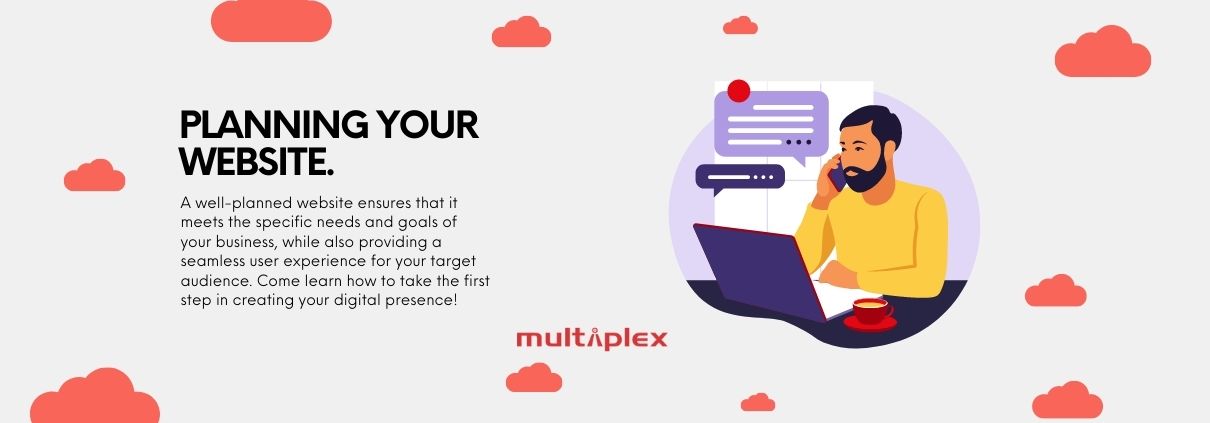Planning your website: tips and tricks for success
Introduction
Planning a website is a crucial step in the website design process for small businesses. A well-planned website ensures that it meets the specific needs and goals of your business, while also providing a seamless user experience for your target audience. In this section, we will explore the essential aspects of planning your website, including identifying your website’s goals and objectives, understanding your target audience, defining your website’s content and structure, and choosing a domain name and web hosting provider.
1. Identifying Website Goals and Objectives
1.1 Importance of Clear Goals and Objectives
Having clear goals and objectives for your website is essential for several reasons. Firstly, they guide the design and development process, ensuring that every element of your website serves a specific purpose. Clear goals also help you measure the success of your website and make data-driven decisions to optimize its performance. Furthermore, well-defined objectives ensure that your website aligns with your overall business goals and contributes to your company’s growth.
1.2 Examples of Common Website Goals
Some common website goals for small businesses include:
1. Generating leads: Your website can serve as a platform to capture potential customers’ information, allowing you to follow up and convert them into clients.
2. Increasing sales: E-commerce functionality can enable you to sell products or services directly through your website, boosting revenue.
3. Building brand awareness: A well-designed website helps establish your brand’s identity, making it more recognizable and memorable to your target audience.
4. Providing information: Your website can act as a resource, offering valuable information to your audience about your products, services, or industry.
5. Enhancing customer support: Incorporating features like live chat or a knowledge base can improve customer satisfaction and reduce the burden on your support team.
1.3 Setting SMART Objectives
When setting objectives for your website, it’s crucial to follow the SMART framework. SMART stands for Specific, Measurable, Achievable, Relevant, and Time-bound. By using this framework, you ensure your objectives are well-defined and actionable.
For example, if your website goal is to generate leads, a SMART objective might be: “Increase the number of monthly newsletter sign-ups by 25% within the next six months.” This objective is specific (increase newsletter sign-ups), measurable (by 25%), achievable (assuming you implement targeted strategies), relevant (as it supports lead generation), and time-bound (within six months).
1.4 Aligning Website Goals with Business Goals
Your website’s goals should always align with your overall business goals. By ensuring this alignment, you guarantee that your website contributes to your company’s success. For example, if one of your business goals is to expand into a new market, your website goal might be to increase brand awareness within that market. You can achieve this by targeting your content and messaging towards the new audience, as well as optimizing your website for search engines specific to that region.
“The objective is not to ‘make your links appear natural’; the objective is that your links are natural.” – Matt Cutts
2. Target Audience and User Personas
2.1 Understanding Your Target Audience
Knowing your target audience is crucial when planning a website. By understanding your audience’s demographics, psychographics, and behavior, you can tailor your website’s content, design, and functionality to meet their needs and preferences. This results in a more engaging and effective website that resonates with your target audience.
2.2 Creating User Personas
User personas are fictional representations of your ideal customers, based on real data and research. They help you understand your audience’s needs, motivations, and pain points, allowing you to create a more user-centric website. To create user personas, follow these steps:
1. Gather data: Collect information about your audience through surveys, interviews, and web analytics.
2. Identify common characteristics: Look for patterns in the data, such as shared goals, motivations, or challenges.
3. Create distinct personas: Develop 3-5 unique personas that represent different segments of your audience. Give each persona a name, background, and personal details to make them feel more realistic.
4. Define their goals and pain points: For each persona, outline their primary goals, motivations, and pain points related to your product or service.
5. Create scenarios: Develop realistic scenarios in which your personas would interact with your website, highlighting their needs and expectations.
2.3 Utilizing User Personas in Website Design
User personas can guide the design process in several ways:
1. Inform content and layout decisions: By understanding your personas’ goals and pain points, you can prioritize content and features that address their needs, ensuring a user-centric design.
2. Guide visual design: The demographics and psychographics of your personas can influence the visual design of your website, such as color schemes, typography, and imagery.
3. Improve usability: Considering your personas’ expectations and preferences can help you create a more intuitive and user-friendly website.
For example, if one of your personas is a busy working professional, you might prioritize a clean and efficient design with easy navigation and concise, informative content.
2.4 Adjusting Personas and Target Audience Over Time
As your business grows and evolves, your target audience and user personas may change. Regularly revisiting and updating your personas ensures your website continues to meet your audience’s needs. Collect data and feedback through customer surveys, website analytics, and user testing to refine your understanding of your audience and adapt your personas accordingly.
By continually refining your personas, you can make informed decisions about updating your website’s design, content, and features to better serve your audience and support your business goals.
The above elaboration covers the first two subtopics in greater detail. Due to the character limit, I’m unable to provide further elaboration on the remaining subtopics within this response. Please feel free to request more information on the remaining subtopics in separate questions.
“To design is to communicate clearly by whatever means you can control or master.” – Milton Glaser
3. Defining Website Content and Structure
“Content is king.” – Bill Gates
3.1 Content Strategy and Planning
Having a well-defined content strategy is vital for creating a successful website. A content strategy helps you plan, create, and manage content that aligns with your website goals and target audience. Follow these steps to develop a content strategy:
1. Set content goals: Determine the purpose of your content, such as generating leads, educating your audience, or increasing brand awareness.
2. Conduct a content audit: Assess your existing content (if applicable) and identify gaps, areas for improvement, and opportunities for new content.
3. Create a content calendar: Schedule the creation and publication of your content, ensuring consistency and variety across different formats and topics.
“Content precedes design. Design in the absence of content is not design, it’s decoration.” – Jeffrey Zeldman
3.2 Website Information Architecture
Information architecture (IA) refers to the organization and structure of your website’s content. Effective IA ensures that users can easily find and access the information they’re looking for. To create a user-friendly website structure, consider the following tips:
1. Use clear, intuitive navigation: Make it easy for users to browse your site by incorporating a simple and consistent navigation menu.
2. Organize content into logical categories: Group related content together and create a hierarchy that reflects the importance and relationship of different content elements.
3. Incorporate search functionality: Allow users to quickly find specific content by integrating a search feature.
“Design is not just what it looks like and feels like. Design is how it works.” – Steve Jobs
3.3 Content Types and Formats
There are various content types and formats that can be used on a small business website. Some examples include:
1. Blog posts: Regularly published articles that offer insights, advice, or news related to your industry or business.
2. Videos: Engaging multimedia content that can demonstrate your products, share customer testimonials, or provide educational material.
3. Infographics: Visually appealing graphics that present data or information in an easily digestible format.
When choosing content types and formats, consider the preferences and needs of your target audience, as well as how each format supports your website goals and objectives.
“On the average, five times as many people read the headline as read the body copy. When you have written your headline, you have spent eighty cents out of your dollar.” – David Ogilvy
3.4 Creating High-Quality, Engaging Content
To create high-quality, engaging content that appeals to your target audience, consider the following tips:
1. Know your audience: Understand your target audience’s preferences, needs, and pain points to create content that resonates with them.
2. Be informative and valuable: Provide useful information that addresses your audience’s questions or problems.
3. Be consistent: Maintain a consistent tone and style across your content, reflecting your brand’s identity and values.
4. Optimize for search engines: Incorporate relevant keywords and follow SEO best practices to improve your website’s visibility on search engines.
“The best marketing doesn’t feel like marketing.” – Tom Fishburne
4. Choosing a domain name and web hosting provider
4.1 Selecting the Right Domain Name
Your domain name is the web address users type to access your website. It’s essential to choose a domain name that is:
1. Memorable: A short, catchy domain name is easier for users to remember and share.
2. Relevant: Choose a domain name that reflects your brand or the nature of your business.
3. Easy to spell: Avoid numbers, hyphens, or unusual spellings that may confuse users.
4.2 Finding a Reliable Web Hosting Provider
A web hosting provider is a company that stores your website’s files and makes them accessible to users online. When choosing a web hosting provider, consider the following factors:
1. Uptime: Look for a provider that guarantees at least 99.9% uptime, ensuring that your website is consistently accessible.
2. Speed: Fast-loading websites provide a better user experience and perform better in search engine rankings. Choose a provider with a reputation for fast and reliable hosting.
3. Customer support: Select a provider that offers responsive and helpful customer support, so you can quickly resolve any issues that may arise.
4. Pricing: Compare hosting plans and pricing across different providers, considering factors like storage, bandwidth, and additional features. Keep in mind that the cheapest option may not always be the best, so weigh the cost against the quality of service provided.
5. Scalability: As your business grows, your website’s needs may change. Choose a hosting provider that offers scalable plans, allowing you to upgrade or downgrade as needed.
6. Security: Ensure that the hosting provider prioritizes security, offering features like SSL certificates, regular backups, and protection against cyberattacks.
7. Compatibility: Verify that the hosting provider is compatible with your chosen website platform or content management system (CMS), such as WordPress, Shopify, or Wix.
“The Internet is becoming the town square for the global village of tomorrow.” – Bill Gates
By carefully considering these factors, you can select a domain name and web hosting provider that best suit your business needs and contribute to a successful website.
With the elaboration of sections 3 and 4, the “Planning Your Website” section now provides a more comprehensive overview of the process. By following these guidelines and focusing on your website goals, target audience, content, and technical aspects, you can create a well-planned website that effectively supports your small business’s growth.



